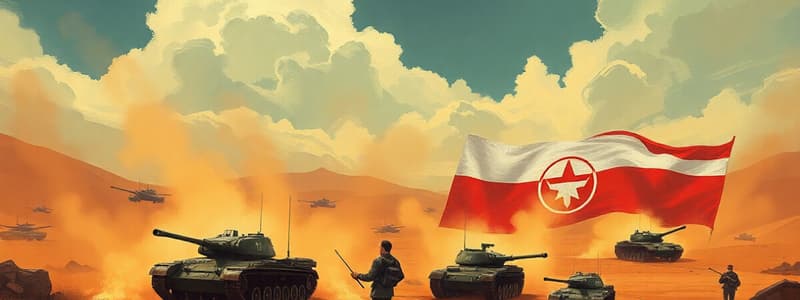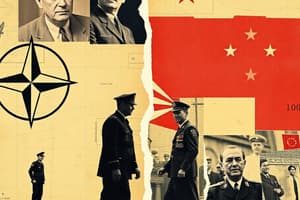Podcast
Questions and Answers
What was the main purpose of the NATO alliance formed in 1949?
What was the main purpose of the NATO alliance formed in 1949?
The main purpose of NATO was to provide collective defense against potential aggression from the Soviet Union and to strengthen Western allies' security.
How did the Warsaw Pact differ from NATO in terms of its formation?
How did the Warsaw Pact differ from NATO in terms of its formation?
The Warsaw Pact was established by the Soviet Union and its satellite states as a response to NATO, focusing on collective defense among communist countries.
What significant event marked NATO's operational engagement during the Cold War?
What significant event marked NATO's operational engagement during the Cold War?
The Korean War (1950-1953) marked NATO's first significant operational engagement, as many allied forces fought under the banner of the United States.
What was the outcome of the Bay of Pigs invasion for the United States?
What was the outcome of the Bay of Pigs invasion for the United States?
What was the Cuban Missile Crisis, and why was it significant?
What was the Cuban Missile Crisis, and why was it significant?
Explain the ideological conflict between capitalism and communism during the Cold War.
Explain the ideological conflict between capitalism and communism during the Cold War.
What impact did the Vietnam War have on the United States' military and society?
What impact did the Vietnam War have on the United States' military and society?
How did the Cold War influence Canada’s defense policies?
How did the Cold War influence Canada’s defense policies?
Flashcards
NATO (North Atlantic Treaty Organization)
NATO (North Atlantic Treaty Organization)
A military alliance formed in 1949 by Western democratic nations, including the United States, Canada, and several European countries, to deter Soviet aggression during the Cold War.
Warsaw Pact
Warsaw Pact
A collective defense treaty established by the Soviet Union and its satellite states in Eastern Europe in 1955. It was a response to NATO and served as a counterweight to Western military power.
Capitalism
Capitalism
An economic system based on private ownership, free markets, supply and demand, and minimal government intervention. It emphasizes individual initiative and competition.
Communism
Communism
Signup and view all the flashcards
Korean War
Korean War
Signup and view all the flashcards
Bay of Pigs Invasion
Bay of Pigs Invasion
Signup and view all the flashcards
Cuban Missile Crisis
Cuban Missile Crisis
Signup and view all the flashcards
Vietnam War
Vietnam War
Signup and view all the flashcards
Study Notes
Cold War Overview
- The Cold War was a period of geopolitical tension between the US and Soviet Union and their respective allies.
- Key aspects included ideological conflicts, proxy wars, and a constant threat of nuclear war.
NATO (North Atlantic Treaty Organization)
- Formed in 1949, NATO was a military alliance of Western democracies.
- Canada was a founding member.
- Initial members included the US, UK, France, and several European nations.
- Other countries joined over time, including West Germany (1955) and Spain (1982)
- NATO acted as a paper organization until the Korean War
Warsaw Pact
- Formed in 1955, the Warsaw Pact was a military alliance of Soviet satellite states in Eastern Europe.
Capitalism vs. Communism
- Capitalism is an economic system based on private ownership, market forces, and minimal government intervention.
- Communism is an economic system based on public ownership, communal control of resources, and a planned economy.
- These two ideologies were in direct conflict during the Cold War.
Korean War (1950-1953)
- The Korean War was the first major conflict of the Cold War.
- NATO's involvement was initially limited, but the war increased Canada's defense budget significantly.
- Canada contributed more than 26,000 soldiers.
Bay of Pigs Invasion (1961)
- A failed US-backed attempt to overthrow the Cuban government.
- CIA trained exiles invaded Cuba but were defeated quickly.
- The invasion served as a propaganda victory for Fidel Castro and Cuba.
Cuban Missile Crisis (1962)
- A direct confrontation between the US and the Soviet Union.
- This was the closest the world came to nuclear war as the USSR placed missiles in Cuba.
Vietnam War (1955-1975)
- A major conflict between communist North Vietnam and South Vietnam, supported by the US.
- Intensified by Cold War tensions.
- Resulted in a communist victory and withdrawal of US forces.
- A devastating conflict leaving many casualties and disabilities.
Fall of the Berlin Wall (1989)
- Symbol of the end of communist rule throughout Eastern Europe and the decline of the Cold War.
Studying That Suits You
Use AI to generate personalized quizzes and flashcards to suit your learning preferences.




